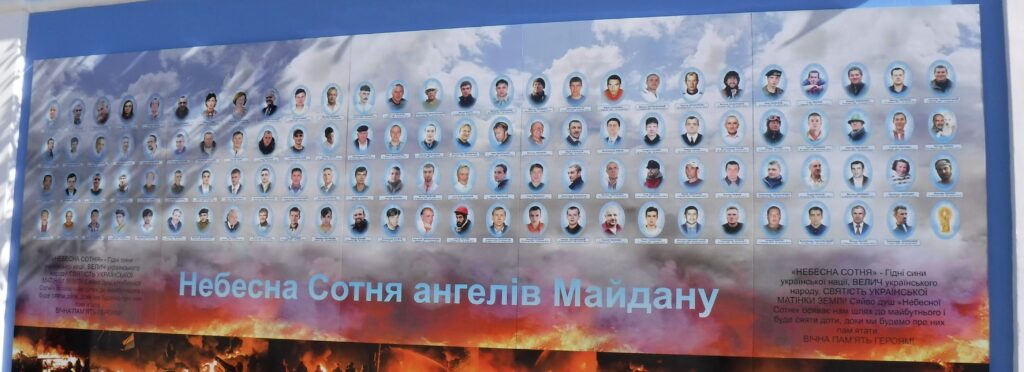Last October I spent a month in Ukraine, and after hiring a car, visited major cities, rural areas and the beautiful Carpathian Mountains. As part of my rental agreement, I had to sign a document stating that I would not take the car to any of the three ‘disputed’ territories currently experiencing military action or Russian occupation: Luhansk, Donetsk, and Crimea. (The Luhansk and Donetsk regions are collectively known as Donbas.)
Ukraine has been at war with Russia, either directly or through their giant neighbour’s support for separatists, for eight years. 14000 people have been killed during the conflict in Donbas1. This was the first, and so far only, country that I have visited that was enduring a ‘hot’ war at the time.

While visiting a decommissioned military base in central Ukraine, I met a soldier who retired from frontline duty after being injured. I reckon he was about my age, maybe a little younger, and was a career soldier. After serving in the military for many years, including stints training in the US, he had retired from the Armed Forces of Ukraine. However when Russian-backed separatists started military action in Donbas, he re-enlisted.
He explained his decision to return to the Army very simply: ‘Donbas is my home’. I asked about the separatists, and whether people from the ‘disputed’ territories generally considered themselves Russian. Although admitting that the Crimean population includes a large number of people who identify as Russians, he was adamant that Donbas was Ukrainian. I asked if Ukraine was aligned with NATO, and he told me that his nation wished to become part of the Organisation. ‘We have been part of Russian before. We know what it’s like. We do not want that again.’
I was talking to a couple in Kiev, and the conversation turned to the war in Donbas. The woman told me that Ukraine, Belarus and Russia ‘are family’, and with such close ties between the peoples of these nations she can’t understand how Russia and Ukraine can be at war.
Her statement reminded me of something I had read at The National Museum of the History of Ukraine in the Second World War. The quote was by a Ukrainian World War II veteran, in an appeal to his former Russian brothers-in-arms: ‘We shared a loaf of bread, we smoked a cigarette for twenty, we protected each other in the trenches! Now, because of Putin…they send your grandchildren to kill ours. My grandson was killed…’2 The woman’s husband told me ‘Now that the Russians have killed their sons, the Ukrainians will never forgive them’.
The people of Kiev built the ‘Memory Wall’ beside St Michael’s Monastery to hold the photographs of Ukrainians killed since 2014 in the war against Russia. A permanent memorial was required after the improvised shrines to the war dead at St Andrew’s Church and the Monastery grew too large.

Also beside St Michael’s is a memorial to the ‘Heavenly Hundred’; the 107 protestors killed (a further 2500 were injured) by Ukrainian security forces during protests against pro-Russian President Viktor Yanukovych in 2013/143.

The National Memorial to the Heavenly Hundred Heroes and Revolution of Dignity Museum explains that people came to the central square to protest that ‘President Viktor Yanukovych had suddenly refused to sign the long-anticipated agreement on Ukraine’s associate membership in the European Union – a document that embodied the nation’s European aspirations in the years following Independence’4. The protests lasted for months, and police brutality towards the protestors was ‘…the catalyst for people outraged by corruption, usurpation of power, the regime’s Russification policy, and rapprochement with Russia’4.
Most of the Heavenly Hundred were gunned down by police on the night of February 20, 20144. The protest was ultimately successful, resulting in the fall of Yanukovych’s government, but not before central Kiev had become a war zone.
With the whole world watching, Russia began a wholesale invasion of Ukraine on February 24. Over the last four days, it has been both confronting and dismaying to see Kiev city landmarks on the news, places that I visited only a few months ago, with dark columns of smoke rising in the background. Tanks and troops entering the city. Missiles landing in Kiev neighbourhoods. Buildings smashed. Firefights in the streets. How can this be happening in 2022?
Will Putin’s desire to bring Russia’s ‘Little Brother’ back into the fold once again see the centre of Kiev ablaze with fire and awash with blood? I wonder how the people I met in Ukraine are faring amongst the fear and chaos.
‘We must not forget how much we have overcome. We wish you a peaceful, happy and prosperous 2022‘
Posted by the National Memorial to the Heavenly Hundred Heroes and Revolution of Dignity Museum on 31st December, 2021
1International Crisis Group, 2022, ‘Conflict in Ukraine’s Donbas: A Visual Explainer‘, International Crisis Group, Brussels
2National Museum of the History of Ukraine in the Second World War, Information panel, National Museum of the History of Ukraine in the Second World War, Kiev
3RFE/RL Ukrainian Service, 2020, ‘Ukraine Marks ‘Heavenly Hundred’s Day’ On Anniversary Of Euromaidan Bloodshed‘, Radio Free Europe/Radio Liberty, Prague
4National Memorial to the Heavenly Hundred Heroes and Revolution of Dignity Museum, ‘About Maidan‘, National Memorial to the Heavenly Hundred Heroes and Revolution of Dignity Museum, Kiev
You may also be interested in Visiting Chernobyl Part I, Part II Museum of Strategic Missile Forces Part I, Part II
If you enjoyed this post, you may also like Dignity, Violence and Violins
Leave a Reply